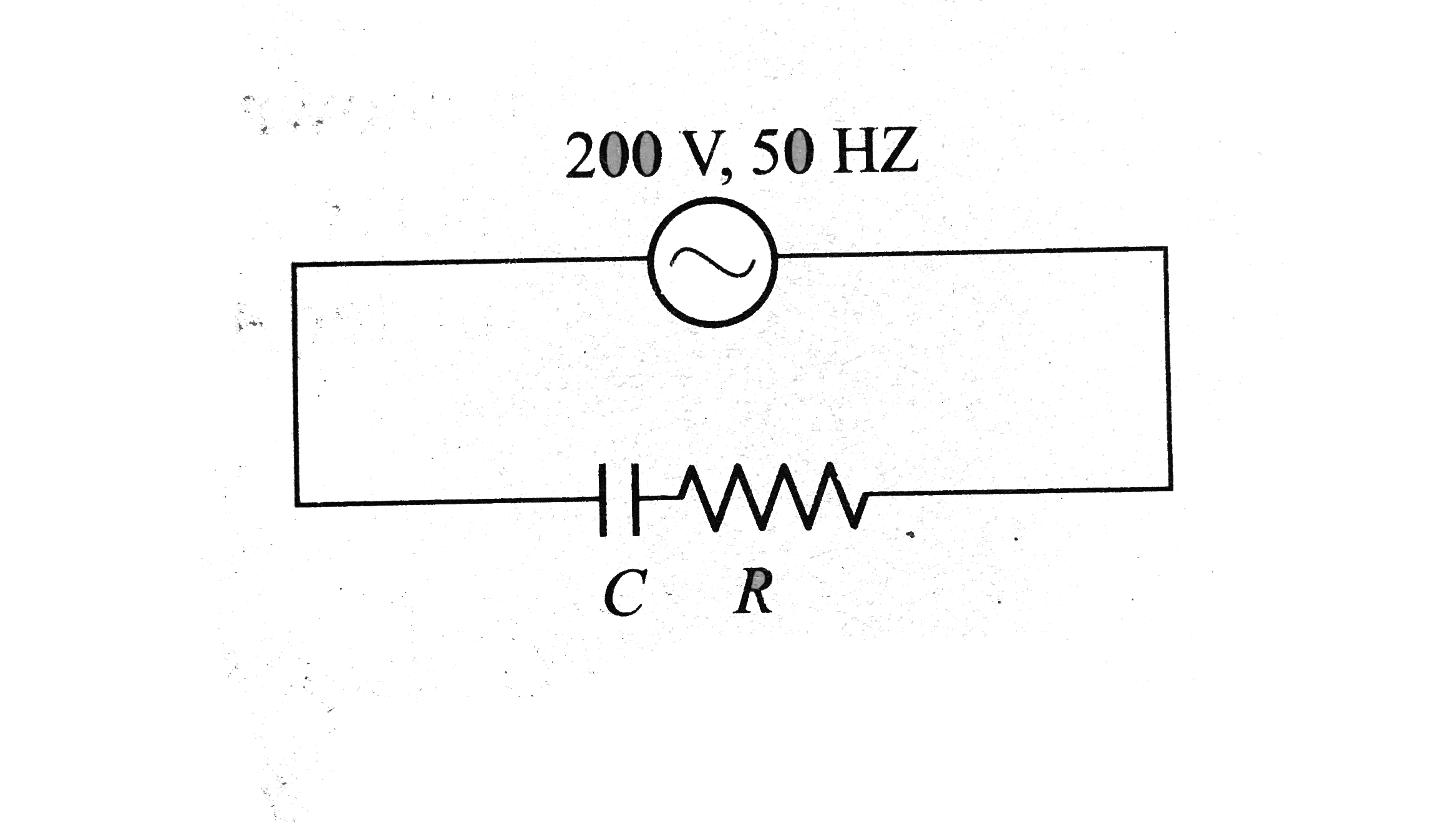In an RC series circuit(in fig), the rms voltage of source is 200V and its frequency is 50 Hz, if R=100ΩandC=100po(μ)F, find
(a) inpedance of the circuit.
(b) power factor angle,
(c ) power factor,
(d) current,
(e) maximum current
(f) voltage across R,
(g) voltage across C,
(h) maximum voltage across R,
(i) maximum voltage across C,
(j) ltPgt,
(k) >PC<.
(m)i(t), VR(t),andVC(t).

The correct Answer is:(a)100√2Ω, (b)45∘, (c ) 1√2, (d) √2A, (e ) 2A (f) √2×100V, (g) √2×100V, (h) 200V, (i) 200V, (j) 200W, (k)200W, (l)0, (m) 2sin(100πt+π4);200sin(100πt+π4);200sin(100πt−π4)
(XC)=106100π(2π50)=100Ω
(a) Z=√R2+x2C=√1002+(100)2=100√2Ω
(b) tanϕ=XCR=1∴Φ=45∘
(c ) Power factor =cosϕ=1√2
(d) Current Irms=VrmsZ=(200)(100√2)=√2A
(e )Maximum current =Imax√2=2A
(f) Voltage across R+VR,rms−IrmsR=√2×100V
(g) Voltage across C=VC,rms−IrmsXC=√2×100V
(h) Max voltage across R=√2VC,rms=200V
(i) Max voltage across C=√2VC,rms=200V
(j) <P≥VrmsIrmscosϕ=200×√2×1√2=200W
(k) <PR>=I2rmsR=200W
(i) lt(P_C)gt =0<br>(m)Appliedvo<a≥canbewrienas:<br>V_(s)(t)=V_(0)sin omega t (omega =2 pi f =2 pi 50 =100 pi rad s^(-1))<br>=200 sqrt(2) sin (1000 pi t)<br>i(t)=I_(0)sin (100 pi t + phi)<br>=(V_0)/(Z) sin (100 pi t +(pi)/(4)) =(200 sqrt(2))/(100 sqrt(2)) sin (100 pi t +(pi )/(4))<br>=2sin (100 pi t +(pi )/(4))<br>V_(R )(t) V_(R0)sin (100 pi t +(pi )/(4)) =I_(0)Rsin (100 pi t +(pi )/(4))<br>=2xx100sin (100 pi t +(pi )/(4))=200sin (100 pi t +(pi )/(4))<br>V_(C )(t)=V_(C0)sin (100 pi t +(pi )/(4)-(pi)/(2))<br>=(I_0)X_(C )sin (100 pi t -(pi )/(4))=200sin (100 pi t -(pi )/(4)).
Topper's Solved these Questions
- ALTERNATING CURRENTBOOK - CENGAGE PHYSICSCHAPTER - ALTERNATING CURRENTEXERCISE - Exercises Single Correct
63 Videos
- ALTERNATING CURRENTBOOK - CENGAGE PHYSICSCHAPTER - ALTERNATING CURRENTEXERCISE - Exercises Multiple Correct
5 Videos
- ALTERNATING CURRENTBOOK - CENGAGE PHYSICSCHAPTER - ALTERNATING CURRENTEXERCISE - Exercise 5.1
15 Videos
- OSCILLATIONSBOOK - CENGAGE PHYSICSCHAPTER - OSCILLATIONSEXERCISE - QUESTION BANK
39 Videos
- ATOMIC PHYSICSBOOK - CENGAGE PHYSICSCHAPTER - ATOMIC PHYSICSEXERCISE - ddp.4.3
15 Videos
Similar Questions
Knowledge Check
In series LCR circuit, the phase difference between voltage across L and voltage across C is
AZeroBπCπ2D2πA 50HzAC source of 20V is connected across R and C as shown in figureure.

The voltage across R is 12V. The voltage across C isA8VB16VC10VDnot possible to determine unless value of R and C are givenIn an L-C-R circuit, if V is the effective value of the applied voltage VR is the voltage across R, VL is the effective voltage across L, VC is the effective voltage across C, then
AV=VR+VL+VCBV2=V2R+V2L+V2CCV2=V2R+(VL−VC)2DV2=V2L+(VR−VC)2
A resistor R and the capacitor C are connected in series across an ac source of rms voltage 5V if the rms voltage across C is 3V then that across R is .
View SolutionIn an LCR series circuit the voltages across R,L and C at resonance are 40Vand60V respectively the applied voltage is .
View SolutionIn a series resonant L-C-R circuit the voltage across R is 100V and R=1kOm with C=2μFthe resonant frequency ω is 200 rads−1 at resonance the voltage across L is
View SolutionIn a series resonant L-C-R circuit the voltage across R is 100V and R=1kOm with C=2μFthe resonant frequency ω is 200 rads−1 at resonance the voltage across L is
View SolutionIn a series LCR circuit containing an AC voltage source of frequency ω, current and voltage are measured. Then for the resistance, consider the statements-
[a] current is maximum at ω2=1/LC
[b] current is minimum at ω2=1/LC
[c] voltage across R is maximum at ω2=1/LC
[d] voltage across R is minimum at ω2=1/LC
the voltage statement is
View Solution

